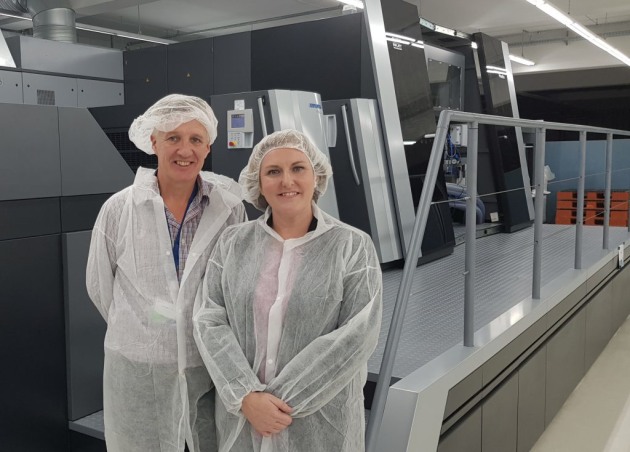The world’s first digital B1 inkjet sheetfed press, the Heidelberg Primefire 106, is now in series production, with 25 packaging printers around the world already in the queue to receive one. PKN attended the launch in Weisloch, Germany this month.
The company has been running beta machines for the past year, but has now installed its first series machine, in Colorado, with its second currently going into a Chinese printer.
Speaking to the world’s trade press at the Heidelberg Packaging Days event at the company’s sprawling manufacturing centre in Weisloch, Heidelberg board director Stefan Plenz said, “Projections for packaging print continue to show growth, and that is really before plastic became such a big issue, any trend away from plastic will boost carton packaging even further.
“Digital packaging will grow fastest of all, it has barely begun, and we predict it will treble in output over the next five years, a 300 per cent growth. Digital packaging is a bit of a chicken and egg situation, there is only a small market at present as the technology has not been developed, however, the launch of the Primefire will give brand owners new options for short run and variable data packaging.
“The Primefire 106 is the first B1 inkjet in the market. It uses water based inks for food safety compliance. It is an industrial scale machine. Its design principles were for a reliable, repeatable, robust digital print solution.”
Plenz says the Primefire 106 is suited to the Australian and New Zealand markets, with its capability to print short runs and variable data. He is dismissive of the concept of runs of one, but says mass customisation is a likely application. He says, “Consumers will drive brands to personalisation, to short run and to quick turnarounds. The same trends that are impacting Europe and the US are seen in Australia, and make the Primefire a clear choice to meet the market.”
Heidelberg then took the trade press to the site of the first Primefire, family owned $70m turnover ColorDruck, deep in the Black Forest, which has been running a beta machine for the past year. Its joint managing director Martin Bruttel said the company had been looking at digital packaging technologies since 2014. It decided to install the Primefire and at the same time launch a web-to-pack service, commissioning a development company to come up with the software.

He says, “We went with Primefire because we have trust and confidence in Heidelberg. Since we installed the machine we have found that the print quality, the registration, the reliability have met our needs. We are using the machine to create a whole new business with our web-to-pack solution of short runs in short time frames, and with personalisation. What Coca-Cola and Nutella did with labels we can do with cartons.”
The Primefire 106 combines the Heidelberg paper transport with Fujifilm print heads. It prints in seven colours at 2,500 sheets an hour. Its initial application is in the packaging sector. Heidelberg says the gamut if the seven colours means there is no need for spot colours to achieve brand colours.
Montserrat Peidro-Insa, Heidelberg’s senior vice president for digital print business said, “The first beta machine is running at 86 per cent uptime, the second at 80 per cent. These are offset figures not digital, which is testimony to the capability of the Primefire, a digital press.
“Primefire is offering printers much more than digital migration, it offers new business opportunities, and contrary to what the Bible says, the last will not be first, the first will be first.”
The Heidelberg Packaging Days comprised a whole series of seminars, workshops and educational sessions, along with machine demonstrations across the range of Heidelberg offset and digital print solutions, and its folding carton and folder gluers from partner MK Masterworks, all under the Smart Printing banner. Among the jobs Heidelberg was printing sheets with inline embellishing including foiling and embossing.
Plenz says, “The printshop today can benefit from full digitisation, whether the output is to an offset plate through CTP or a digital press like Primefire. It is important that today’s printer automates and digitises the workflow as much as possible, to achieve the highest operational efficiencies.”







